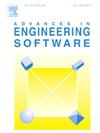A novel binomial-based fuzzy type-2 approach for topology and size optimization of skeletal structures
IF 4
2区 工程技术
Q2 COMPUTER SCIENCE, INTERDISCIPLINARY APPLICATIONS
引用次数: 0
Abstract
The current work introduces a new probability-based fuzzy type-2 decision mechanism to adjust the optimization process during the simultaneous size and topology optimization of the Skeletal structural systems. For the probabilistic part a binomial module is developed that feeds the fuzzy mechanism by forecasting success probability for future topological actions. The proposed fuzzy decision mechanism permanently monitors the optimization process and attends to dynamically tune the balance between size and topology actions. The presented strategy, by reducing the number of ineffective iterations, significantly enhances the efficiency of the optimization process. Since the proposed decision mechanism is designed as an auxiliary separate module it can be integrated with different optimization methods. Accordingly, in this study, it is integrated with four different optimization algorithms and applied to solve distinct size and topology problems. To comprehensively evaluate the effect of the proposed strategy a new performance index is defined and employed. The acquired results demonstrate that the proposed decision mechanism considerably enhances the search performance of the algorithms on handling the structural size and topology optimization problems.
基于二项式的新型模糊 2 型骨骼结构拓扑和尺寸优化方法
目前的工作引入了一种新的基于概率的模糊 2 型决策机制,用于调整骨架结构系统同时进行尺寸和拓扑优化时的优化过程。在概率部分,开发了一个二项式模块,通过预测未来拓扑行动的成功概率为模糊机制提供信息。所提出的模糊决策机制可对优化过程进行长期监控,并对尺寸和拓扑结构行动之间的平衡进行动态调整。所提出的策略通过减少无效迭代次数,显著提高了优化过程的效率。由于所提出的决策机制被设计为一个独立的辅助模块,因此可以与不同的优化方法相结合。因此,本研究将其与四种不同的优化算法相结合,并应用于解决不同的尺寸和拓扑问题。为了全面评估所提策略的效果,定义并使用了一个新的性能指标。研究结果表明,建议的决策机制大大提高了算法在处理结构尺寸和拓扑优化问题时的搜索性能。
本文章由计算机程序翻译,如有差异,请以英文原文为准。
求助全文
约1分钟内获得全文
求助全文
来源期刊

Advances in Engineering Software
工程技术-计算机:跨学科应用
CiteScore
7.70
自引率
4.20%
发文量
169
审稿时长
37 days
期刊介绍:
The objective of this journal is to communicate recent and projected advances in computer-based engineering techniques. The fields covered include mechanical, aerospace, civil and environmental engineering, with an emphasis on research and development leading to practical problem-solving.
The scope of the journal includes:
• Innovative computational strategies and numerical algorithms for large-scale engineering problems
• Analysis and simulation techniques and systems
• Model and mesh generation
• Control of the accuracy, stability and efficiency of computational process
• Exploitation of new computing environments (eg distributed hetergeneous and collaborative computing)
• Advanced visualization techniques, virtual environments and prototyping
• Applications of AI, knowledge-based systems, computational intelligence, including fuzzy logic, neural networks and evolutionary computations
• Application of object-oriented technology to engineering problems
• Intelligent human computer interfaces
• Design automation, multidisciplinary design and optimization
• CAD, CAE and integrated process and product development systems
• Quality and reliability.
 求助内容:
求助内容: 应助结果提醒方式:
应助结果提醒方式:


